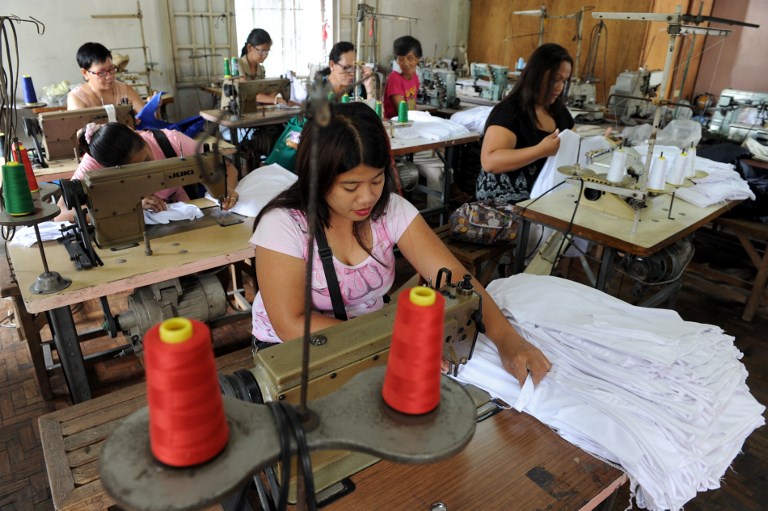
Women work at a clothing manufacturing firm in Manila. AFP FILE
The manufacturing sector sustained its strong performance in the fourth quarter of 2018 even as its growth slightly weakened in December, the latest Nikkei Philippines Manufacturing Purchasing Managers’ Index (PMI) showed.
Last month, the PMI score slightly declined to 54.2 from 54.8 in November, global research firm IHS Markit said in a statement Tuesday.
IHS Markit nonetheless pointed out that the index level in December “still signalled a solid improvement in the health of the sector” as the fourth-quarter average was the strongest last year.
A PMI score of above 50 indicates an overall increase in manufacturing activity.
“The Philippines’ manufacturing economy finished the year with its best quarter for 2017, setting the scene for stronger growth as the country moves into [2018]. Output and new orders maintained marked growth rates in December. Domestic demand stood out as a key driver for manufacturing activity as export growth remained subdued,” IHS Markit principal economist Bernard Aw said.
“Other survey indicators point towards a strong start to 2018 for the sector. Business expectations about output in the year ahead strengthened to a four-month high while firms increased labor capacity and purchasing activity further during December,” Aw added.
“Meanwhile, the PMI’s gauge of input prices, which exhibits a strong relationship with official consumer inflation data, slowed in December, suggesting headline inflation may have peaked and is likely to turn down from its current three-year high. Notably, inflation has been pushed higher by increased oil and food prices as well as a weak exchange rate. As these pressures subside, the likelihood is inflation will remain within the central bank’s target of 2-4 percent in 2018,” according to Aw.
Last week, the Bangko Sentral ng Pilipinas said it expected inflation in December to settle within the range of 2.9-3.6 percent, similar to its forecast in November and faster than a year ago.
“Higher domestic petroleum and rice prices could contribute to upward price pressures, which could be partly offset by the decline in Meralco’s electricity rates and stronger peso,” according to the BSP, citing the projection of its department of economic research.
The projected range for December was higher than the actual 2.6-percent inflation rate posted a year ago.
The BSP projected the same range for the month of November, while the actual rate of increase in prices of basic goods that month eased to 3.3 percent following the three-year high of 3.5 percent in recorded in October.
The BSP said that its forecast range for December “brings full-year 2017 inflation to average at 3.2 percent, well within the target for the year.”
During its last meeting on monetary policy last Dec. 14, the BSP’s policy-making Monetary Board maintained its inflation forecasts of 3.2 percent for 2017, 3.4 percent for 2018, and 3.2 percent for 2019.
As of November, headline inflation averaged 3.2 percent.
For the period 2017 to 2020, the government targets inflation to settle within the range of 2-4 percent. /cbb